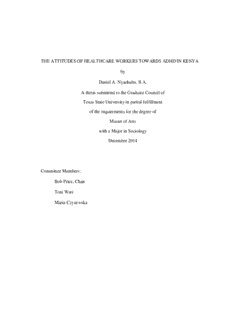
THE ATTITUDES OF HEALTHCARE WORKERS TOWARDS ADHD IN KENYA by Daniel A ... PDF
Preview THE ATTITUDES OF HEALTHCARE WORKERS TOWARDS ADHD IN KENYA by Daniel A ...
THE ATTITUDES OF HEALTHCARE WORKERS TOWARDS ADHD IN KENYA by Daniel A. Nyachuba, B.A. A thesis submitted to the Graduate Council of Texas State University in partial fulfillment of the requirements for the degree of Master of Arts with a Major in Sociology December 2014 Committee Members: Bob Price, Chair Toni Watt Maria Czyzewska COPYRIGHT by Daniel A. Nyachuba 2014 FAIR USE AND AUTHOR’S PERMISSION STATEMENT Fair Use This work is protected by the Copyright Laws of the United States (Public Law 94-553, section 107). Consistent with fair use as defined in the Copyright Laws, brief quotations from this material are allowed with proper acknowledgement. Use of this material for financial gain without the author’s express written permission is not allowed. Duplication Permission As the copyright holder of this work I, Daniel A. Nyachuba, authorize duplication of this work, in whole or in part, for educational or scholarly purposes only. DEDICATION I dedicate this thesis to my brother, Dr. David Nyachuba, who taught me the value of education. ACKNOWLEDGEMENTS I am grateful, and hereby acknowledge, the guidance and other help from my Chair Dr. Bob Price, and my committee members Dr. Toni Watt and Dr. Maria Czyzewska. Second, I thank the Center for Social Inquiry and the Graduate College for the grant and the Graduate College Thesis Research Support Fellowship respectively, which enabled me to travel to Kenya to collect data. I would also like to thank the healthcare workers who completed my questionnaire and numerous other persons who assisted or collaborated with me in the course of this research. Thank you all. v TABLE OF CONTENTS ACKNOWLEDGEMENTS ................................................................................................v LIST OF TABLES ........................................................................................................... vii LIST OF FIGURES ......................................................................................................... viii ABSTRACT .........................................................................................................................x CHAPTER 1. INTRODUCTION ............................................................................................. 1 1.1. Background ..........................................................................................1 1.2. Statement of Problem ............................................................................8 1.3. Research Questions .............................................................................. 8 1.4. Rationale for the Study .........................................................................8 2. LITERATURE REVIEW ....................................................................................9 2.1. The Trend of ADHD Diagnosis ............................................................9 2.2. ADHD and the Diagnostic and Statistical Manual for Mental Disorders (DSM) ................................................................................11 2.3. Main Perspectives of Mental Illnesses ................................................12 2.4. ADHD as a Bona Fide Mental Illness.................................................14 2.5. Attitudes of General Practitioners towards ADHD ............................17 2.6. Drivers of Increased ADHD Diagnosis ..............................................18 2.6.1. Earlier drivers of medicalization ..........................................18 2.6.2. Emergent drivers of medicalization .....................................21 2.7. Theories of Medicalization .................................................................22 2.8. Theoretical Framework .......................................................................28 3. METHODOLOGY ............................................................................................30 vi 3.1. Research Design..................................................................................30 3.2. Research Strategy................................................................................30 3.2.1. Population ............................................................................31 3.2.2. Sampling technique .............................................................31 3.3. Data Analysis ......................................................................................32 4. FINDINGS .........................................................................................................33 4.1. Legitimacy of ADHD as a Diagnostic Category ................................34 4.2. When ADHD Medication Should Be Used ........................................36 4.3. Pressure to Diagnose ...........................................................................39 4.4. The Seriousness of the Side Effects of the ADHD Medications ........42 4.5. Appropriateness of ADHD Diagnosis and Treatment ........................44 4.6. Concern for ADHD Misdiagnosis ......................................................46 5. CONCLUSION .................................................................................................48 5.1. Future Research ................................................................................ 50 APPENDIX SECTION ..........................................................................................51 REFERENCES ......................................................................................................56 vii LIST OF TABLES Table Page 1. Demographic Variables ...............................................................................................33 viii LIST OF FIGURES Figure Page 1. Model of Relationships between Psychiatrists, Clients, Pharmaceutical Companies, and the State .................................................................................................................14 ix ABSTRACT The diagnosis of ADHD is becoming common in Kenya and the rest of Africa. Local researchers, however, have paid little attention to the mental disorder. This study investigates the attitudes of mental health care workers towards ADHD in Kenya. It is their attitudes that will most directly determine the rates of ADHD diagnosis and the kind of treatment administered as ADHD becomes more relevant in the coming years. ADHD treatment can be pharmacological or non-pharmacological. A sample of 84 nurses, physicians, and psychiatrists working in public, private, and faith-based hospitals in Nairobi, Kenya were asked about their views with open ended and closed ended questions. The data were analyzed qualitatively. Broadly speaking, health care workers believed that ADHD was a legitimate psychiatric diagnosis. Medical professionals appealed to both neurobiological and psychodynamic views to legitimate ADHD as a genuine mental illness. Respondents said that ADHD was not being diagnosed and treated appropriately in Kenya. Respondents pointed to lack of awareness by parents and teachers, inadequate knowledge and experience on the part of medical professionals, and insufficient follow-up by medical facilities as some of the challenges hindering proper ADHD diagnosis and treatment. Health care workers were aware of the side effects of ADHD medication, but were divided on the seriousness of those side effects. To some, side effects were considered mild and an acceptable cost of being on medication, whereas others expressed more worry that the side effects were serious, but nevertheless saw medication as necessary in severe cases. Respondents did not report feeling pressure to diagnose and prescribe ADHD medications. Overall, the results support the assertion that inattention and hyperactivity has been medicalized in Kenya. x
Description: